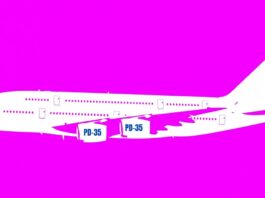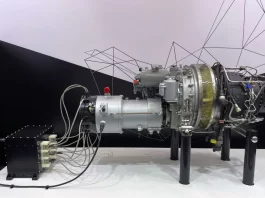The Kuznetsov NK-25 is a three-shaft low-bypass afterburning turbofan engine that was developed by the Kuznetsov Design Bureau during the Soviet era in the early 1970s. The design work took place between 1972 and 1974. It is largely recognized for its usage in the Tupolev Tu-22M series strategic bomber, a supersonic aircraft that is highly capable. The NK-25 is one of the most potent Russian supersonic aircraft engines still in service, producing a maximum thrust of approximately 245 kN (55,000 pounds-force) with the afterburner. A four-stage axial turbine is paired with a three-stage low-pressure compressor, a five-stage intermediate-pressure compressor, and a seven-stage high-pressure compressor in the engine’s compressor configuration. It has an overall pressure ratio of approximately 25.9 and a bypass ratio of approximately 1.45. The thrust-to-weight ratio is nearly 7, and the turbine inlet temperature reaches approximately 1,597 K (1,324°C), indicating its efficacy for its era.
The NK-25 is more accurately described as an evolutionary development that succeeded the NK-22. The NK-22 is a two-shaft low-bypass afterburning turbofan that was used to power the Tupolev Tu-22M bomber in its earlier versions. It is capable of producing a maximum afterburning thrust of approximately 216 kN (48,500 pounds-force). The NK-22 is equipped with a three-stage turbine and a 12-stage axial compressor, resulting in a bypass ratio of approximately 0.6 and a pressure ratio of approximately 14.75. The NK-25 is a significant technological advancement, boasting improved pressure ratios, thrust, and overall performance.
There are many noteworthy derivatives within the Kuznetsov engine family:
The NK-32-02 (Series 2) is a modernized variant of the NK-32 engine, which was originally developed as a powerful afterburning three-spool turbofan that generated thrust levels of approximately 245 kN (55,000 pounds-force). The Tupolev Tu-160 strategic bomber, which is the largest and quickest supersonic bomber in service, is powered by the NK-32. The NK-32-02 further refines the original by incorporating new compressor and turbine blade designs and enhanced cooling, which leads to greater fuel efficiency and an operational range that is approximately 1,000 kilometers (620 miles).
The PD-30 engine is a geared high-bypass turbofan that is derived from the NK-32. It is built to generate a thrust of approximately 290 kN (approximately 30,000 kgf). This engine is being considered for the purpose of powering an upgraded version of the Antonov An-124 heavy transport aircraft, with a concentration on enhanced fuel efficiency and fleet modernization. It is also intended for use in new Russian wide-body airliners.
The NK-65 is a non-afterburning variant that is presently being developed for the next-generation Russian strategic bomber project, PAK DA. It is based on the NK-32 core. The NK-65 is designed to balance fuel economy with performance to provide a reliable and efficient propulsion system for this covert, long-range bomber. The NK-65 has been selected as the powerplant for PAK DA, and engine development is currently underway, according to official sources.
The NK-34 is a turbojet engine that is designed for use in seaplanes. Although there is less comprehensive public information available regarding this engine, it is a component of Kuznetsov’s overarching strategy to equip specialized aircraft types. This plan is consistent with Russia’s pursuit of aviation assets that are adaptable and capable of operating in maritime environments.
The NK-44 is a high-thrust turbofan engine that is reported to have a maximum thrust of approximately 400 to 450 kN. Although this engine was proposed for large aircraft, including the Ilyushin Il-96 wide-body airliner, it did not achieve widespread production or service. It continues to be a component of the Kuznetsov legacy, which involves the development of robust high-bypass turbofans for commercial and heavy transport applications.
The Kuznetsov Design Bureau has a rich history, beginning with the development of engines such as the NK-12 turboprop, which were widely used from the 1950s onward and were renowned for their exceptional strength. Kuznetsov has developed a diverse array of aviation propulsion systems over the course of several decades, including turboprops and turbofans, as well as rocket engines classified under the “NK” lineup. Notable rocket motors include the NK-9, NK-15, and NK-33. This lineage showcases a continuous evolution in propulsion technology, with numerous engines demonstrating enhancements in efficiency, thermodynamics, and materials that are specifically designed for both military and civilian aircraft applications.
In conclusion, the assessment of the NK-25 and its associated NK engine family members underscores Kuznetsov’s substantial legacy of inventive, powerful propulsion solutions. The NK-25 is not merely a derivative of the NK-22, but rather a mature development of it. Its numerous derivatives, including the NK-32-02, which is used to power strategic bombers; the PD-30, which is designed for future airliners; and the NK-65, which is specialized for next-generation military aircraft, serve as a testament to the continuous development of Russian aerospace propulsion. The NK-34 and NK-44 further underscore Kuznetsov’s versatility in accommodating a variety of aviation requirements, including seaplanes and large commercial transports. Overall, Kuznetsov’s contribution to the design of aero engines emphasizes its critical significance in the annals of aerospace engineering in both the Soviet Union and Russia.
Official Website of Youtube Channel – Altitude Addicts




